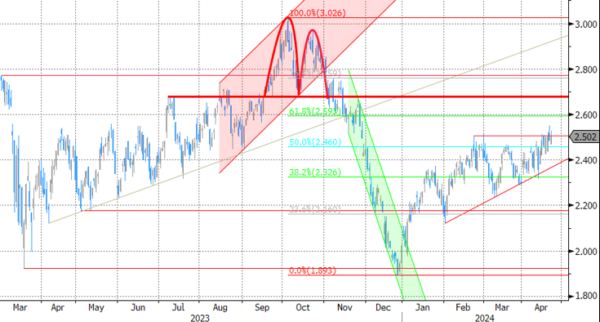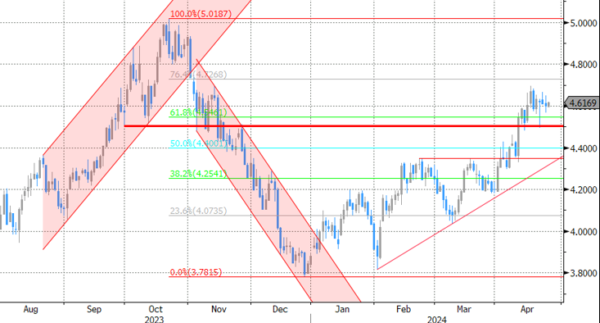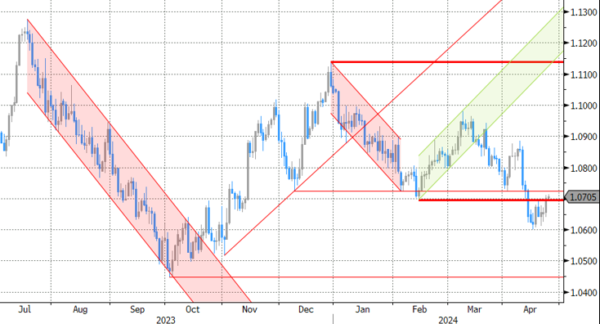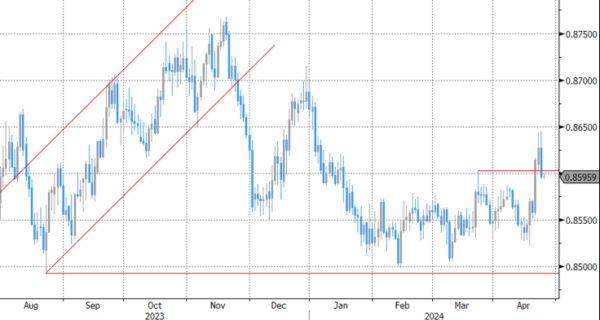Markets
Disappointing April US PMI’s triggered some short covering in US Treasuries. The composite PMI declined from 52.1 to 50.9 (vs 52 consensus) with both manufacturing (49.9 from 51.9) and services (50.9 from 51.7) contributing. Details showed inflows for new business falling for the first time in six months and firms’ future output expectation slipping to a 5-month low. Both suggest that the US economy could lose some further momentum in the second quarter of the year. Companies cut payrolls numbers (48.5 from 51.2) at the fastest pace since May 2020. Weaker demand and a less tight labour market fed through to an easing in rates of increase of selling prices. Details show dynamics of inflation changing from wage-related services-led price pressures to intensifying factory cost pressures (higher raw material and energy). Markets went into yesterday’s PMI’s following a string of strong activity/labour market data and higher CPI releases. This context made markets vulnerable to some milder positioning going into next week’s FOMC meeting. We don’t expect PMI’s to be trend-reversers though. Daily changes on the US yield curve eventually varied between -3.9 bps (2-yr) and +1.4 bps (30-yr) with yields closing off intraday lows. European bonds yesterday underperformed following consensus-beating PMI’s. The context was obviously different with Europe coming from a period of weakness. German yields added 1.5 bps to 2.5 bps. The combination of better EMU and worse US numbers propelled EUR/USD from 1.0639 to 1.0701 with the pair trying to sustainably regain the previous YTD low at 1.0694. Sterling was yesterday’s outperformer in FX space as BoE chief economist offered some counter weight to recent soft comments by BoE Baily and Ramsden, suggesting that the MPC is currently split on how long policy rates should remain at their current peak levels. EUR/GBP returned below 0.86. Today’s eco calendar contains German Ifo business climate, US durable goods orders, a record-volume $70bn 5-yr Note auction and an avalanche of Q1 earnings. After yesterday, we expect the yields and the dollar to temporarily lose some momentum.
News & Views
The National bank of Hungary (MNB) yesterday slowed the pace of rate cuts. The base rate was reduced by 50 bps to 7.75% compared to a 75 bps reduction in March. The MNB sees persistently moderating inflation. Rising real wage growth and strengthening confidence support a gradual economic recovery, mainly driven by domestic demand. (2-3% growth this year). Headline CPI inflation fell within the MNB’s tolerance band (3.6% Y/Y in March). Core inflation remained higher at 4.4%, but in line with the MNB March projection. The MNB expects the pace of price increases to rise temporarily in the middle of this year. The decline in core inflation might stop in Q2 and is expected to fluctuate between 4.5% and 5% in the remainder of the year. Financial stability considerations remain important in the MNB’s policy assessment. High FX reserves and the persistent improvement in the current account balance have contributed to the strengthening of the country’s risk perception. Still, the risk premium on Hungarian assets has risen recently in a deteriorating international sentiment. The outlook for inflation combined with a volatile risk environment warrant a carful, patient approach to monetary policy, resulting in a slower pace or rate reductions than was the case earlier. KBC expects two additional 50 bps rate cuts in May and June, before a further slowdown of easing in H2. The forint yesterday gains modestly to close the session near EUR/HUF 393.
Australian Q1 CPI printed at 1.0% Q/Q and 3.6% Y/Y, compared to 0.6% Q/Q and 4.1% Y/Y in the final quarter of last year. The outcome disappointed expectations for a faster disinflation. Also underlying measures of inflation (trimmed mean 1.0% Q/Q and 4.0% Y/Y) printed higher than expected. In a quarterly perspective, price increases for food (+0.9%), housing (+0.7%), health (2.8%) and education (+5.9), contributed to the rise. Prices for clothing and footwear declined 1.1% Q/Q. Good prices were up 0.5% Q/Q, but services inflation still printed at a strong 1.4% Q/Q. Both headline and core (trimmed mean) inflation stay well above the RBA’s 2-3% target band. Stubbornly high inflation, especially for the likes of services/non-tradeable goods, doesn’t allow the RBA to cut interest rates anytime soon. Australian yields jumped higher this morning with the 3-y government bond yield adding 17 bps (to 4.01%). Markets now see only a small chance (< 30%) for a fist rate cut by the end of the year. The prospect for protracted interest rate support also propelled the Aussie dollar with AUD/USD regaining the 0.65 mark (0.652).
Graphs
GE 10y yield
ECB President Lagarde clearly hinted at a summer (June?) rate cut and seems to have broad backing. EMU disinflation will continue the next two months and bring headline CPI (temporary) at/below the 2% target. Together with weak growth momentum, this gives backing to deliver a first 25 bps rate cut. A more bumpy inflation path in H2 2024 and the Fed’s higher for longer strategy make follow-up move difficult.
US 10y yield
The March dot plot contained several hawkish elements including a symbolically higher neutral rate. In our view they set the stage for a later (September at the earliest) start of a possibly shallower cutting cycle. Upcoming CPI readings (through base effects) and resilient eco data should confirm this. US yields continue to enjoy a solid bottom across the maturity spectrum, setting fresh YTD highs.
EUR/USD
Economic divergence (US > EMU) and a likely desynchronized rate cut cycle with the ECB exceptionally taking the lead pulled EUR/USD towards the YTD low at 1.0695. Stronger-than-expected US March inflation figures forced a technical break, opening the path to last year’s low at 1.0494.
EUR/GBP
Debate at the Bank of England is focused at the timing of rate cuts. Most BoE members align with the ECB rather than with Fed view, suggesting that the disinflation process provides a window of opportunity to make policy less restrictive (in the near term). Sterling’s downside turned more vulnerable with the topside of the sideways EUR/GBP 0.8493 – 0.8768 trading range serving as the first real technical reference.
















